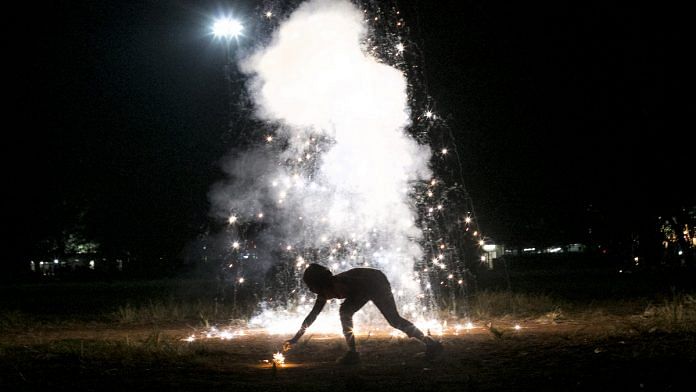New Delhi: Residents in Delhi-NCR, despite Supreme Court’s ban, burst crackers with impunity on Diwali leading to a massive jump in air pollution levels.
According to a report released Tuesday by the Centre for Science and Environment (CSE), there was a 10-fold increase in PM 2.5 levels — an air pollutant — on Diwali night, showing the overwhelming effect crackers can have on the environment.
“There was a 10-fold jump in PM 2.5 concentrations between 5 pm and 1 am due to bursting of firecrackers. The peak level during 1 am to 3 am was quite similar to the peak levels observed in 2018 during Diwali,” the report stated.
Scientists at the CSE analysed real-time data to show how air quality in Delhi and National Capital Region dropped to the season’s worst on Diwali night owing to bursting of crackers.
The CSE report said Delhi recorded relatively clean air between 15 September and October 27 (Diwali). But bursting of crackers spoiled the air in the city.
“While harsher winter conditions are yet to set in and the weather during the period of analysis has remained relatively favourable (including a delayed monsoon), several ongoing systemic actions and preventive emergency measures had also contributed to prevent an early onset of very poor and severe pollution in Delhi-NCR. The scenario has changed on Diwali night,” said Anumita Roychowdhury, executive director, research and advocacy, CSE.
Also read: Pollution monitors max out on Diwali night, CPCB says it’s studying impact of firecrackers
Ghaziabad’s AQI went beyond 1,790
Ghaziabad became the first in the NCR to record the season’s first 24-hour average severe pollution on the day of Diwali. According to Abhilasha Purwar, founder of BlueSky Analytics, Ghaziabad’s Air Quality Index (AQI) went beyond 1,790 in some areas on Diwali. BlueSky Analytics is an agency that monitors air pollution.
The CSE used real-time pollution data from the Central Pollution Control Board to assess the pollution level on Diwali, before Diwali and the overall level since 15 September.
The researchers also compared the pollution levels between this year’s and last year’s Diwali. In 2018, Diwali was celebrated on 7 November — 11 days later — and it was colder. Post-Diwali, the AQI had reached 642 last year. This year, the AQI on the day after Diwali was 368 in Delhi.
According to the CSE report, the air quality changed drastically from being very clean in the afternoon to being severely polluted after 10 pm on this Diwali. However, warmer and windier conditions helped the pollution levels fall sharply after 3 am.
‘Crackers undid the relatively better air quality’
This year, there was no severe pollution days in the week preceding Diwali. In 2018, Delhi-NCR had already experienced a couple of days of ‘severe’ pollution, with many more days of ‘very poor’ air quality before Diwali.
The onset of ‘poor’ and ‘very poor’ days has been delayed this winter. They started to occur only after 10 October. But in 2018, there were more such days, largely starting as early as 26 September.
According to the CSE, favourable weather and government action together have tamed winter pollution this year to some extent.
“It is important to note that overall pollution levels are comparatively lower in Delhi and NCR towns since September 15. While favourable weather conditions have contributed to this trend, the role of ongoing action and emergency interventions have also been important,” the CSE said in its report.
This has prevented build-up of pollution to ‘very poor’ and ‘severe’ levels before Diwali, and has also enabled quicker dissipation of pollution post-Diwali.
It is more important to note that in 2019, there have been days with wind speeds lower than that of last year and yet pollution has not exceeded 2018 levels. Even on days with better wind conditions in 2018 leading to Diwali, the pollution level was higher compared to this year — this shows that the overall pollution load in Delhi in 2018 must have been higher.
The report concluded by saying that firecrackers temporarily undid the comparatively better air quality gains of this season due to favourable weather, ongoing pollution-control action and preventive emergency measures.
“It is absolutely necessary that action is now stepped up to ensure that Delhi and NCR do not plunge into a prolonged smog episode this winter,” said Roychowdhury.
Also read: Why Kejriwal and Modi govt can’t agree on source of Delhi’s air pollution







Diwali crackers leave Delhi-NCR gasping as air quality drops to season’s worst: CSE report/Hum hai Hindustani…..Ache din or poor.